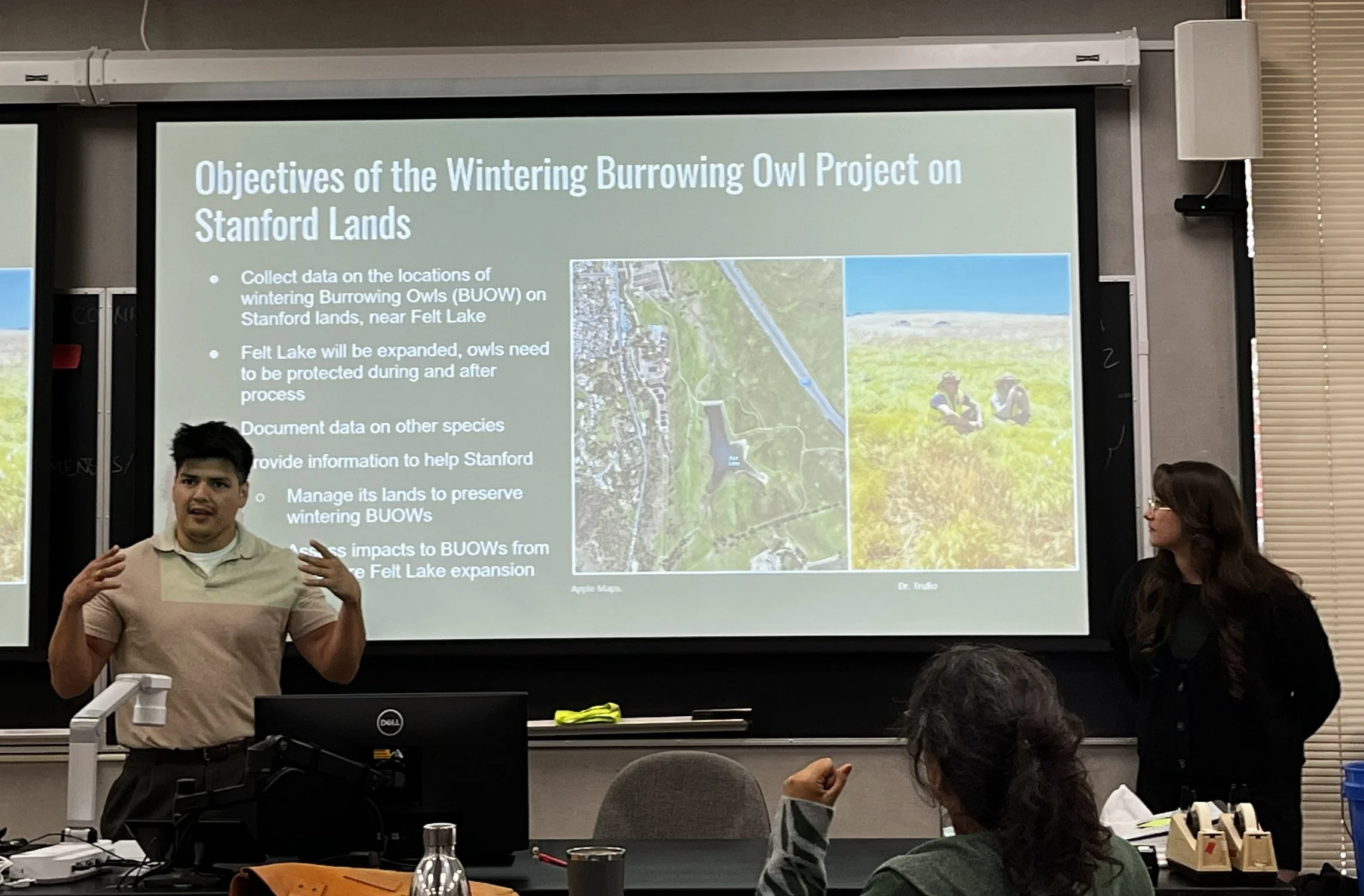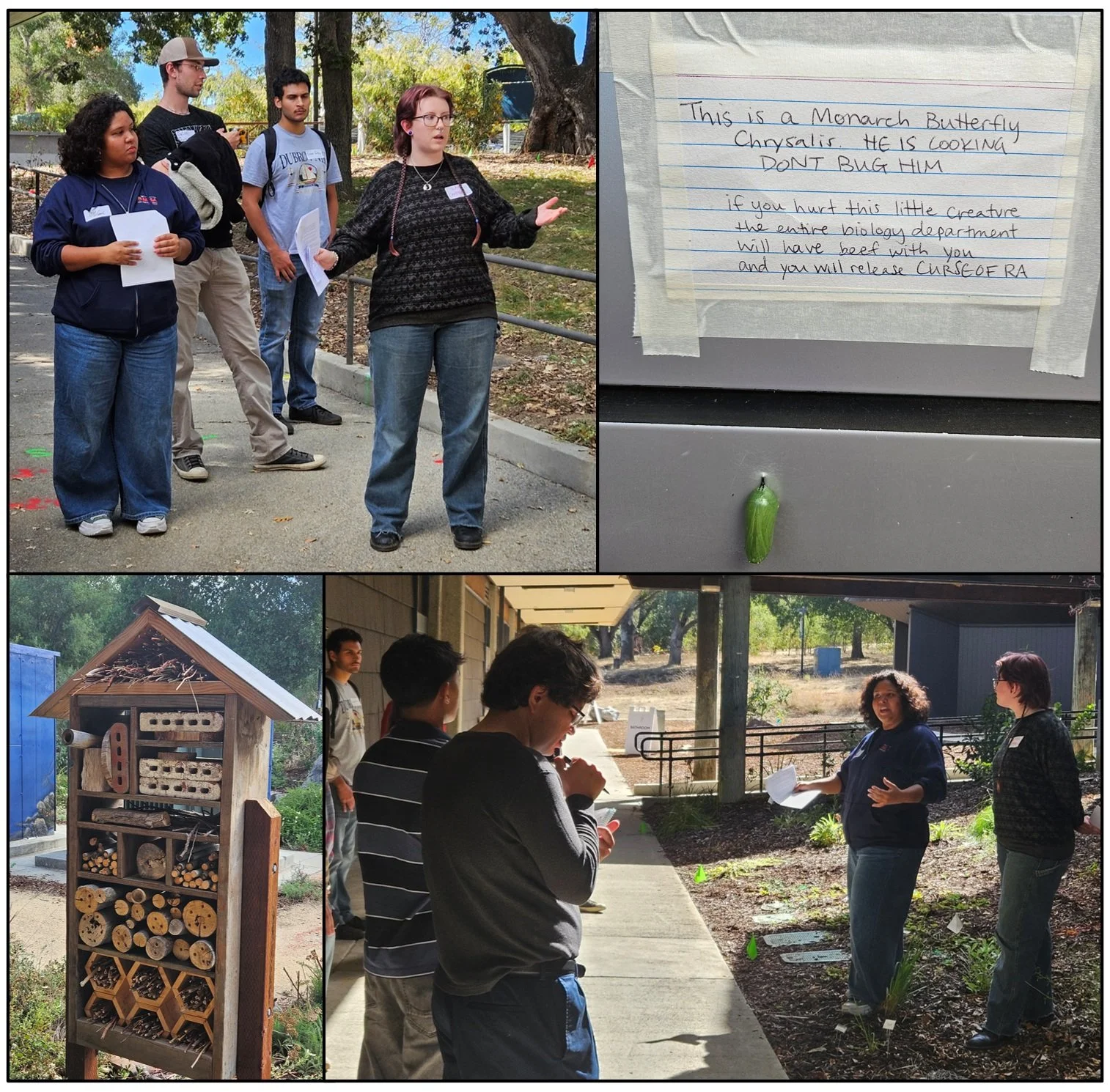Third SOAR All-Hands Symposium highlights student success and local collaboration in avian biology
October 10, 2025
by Katie Glover
SOAR partners and students
On October 10, 2025, the San Francisco Bay Research Coordination Network for Student Opportunities in Avian (SOAR) met for its third All-Hands Symposium. SOAR partner Leticia Gallardo, Instructor and Co-Chair of the Biology Department, created an ideal setting for a day of inspiration, collaboration, and reflection at West Valley College. Student-created banners welcomed us to the Science and Math Building and natural history lab, which was decorated with stunning murals of cell structures and the ecosystems of giant kelp and Coast Redwood canopy forests.
“Seeing students light up about birds and have success in research has changed my path. Birds are a gateway to an interest in ecology.”
- Justen Whittall, SCU Professor and SOAR partner
A Year in Review: Connection and Growth
Once we settled in, our morning session had a dynamic group of 26 students, faculty, and partners who hailed from West Valley College (WVC), Santa Clara University (SCU), San Jose State University, University of California - Santa Cruz (UCSC), San Francisco Bay Bird Observatory (SFBBO), and Stanford University including JRBP ('O'O). Co-Principal Investigator Professor Rodolfo Dirzo set the stage to review our collective activities and growth over the past year. We developed an impressive display of Year 3 activities and student accomplishments in line with SOAR goals (Figure 1). One notable collaboration and success was the SOAR Weekend Intensive field course, thanks to a dedicated teaching team from Stanford, SJSU, SCU, UCSC, SFBBO and WVC, and the student participants from each of these institutions. SCU Professor and SOAR partner Justen Whittall shared the personal testimonial, “Seeing students light up about birds and have success in research has changed my path. Birds are a gateway to an interest in ecology.”
Rodolfo Dirzo (Stanford faculty, left) and Esther Cole Adelsheim (Stanford Conservation Program, right) led SOAR participants in a reflection on Year 3 accomplishments in the morning session. Photo credit: JRBP ('O'O) staff.
The concept of “gateway” experiences was further underscored with student participants. WVC SOAR interns Claire Campbell and Melanie Zarza shared how they have benefited from the mentorship and continuity of former SOAR interns Nick Verdi, James Elliott, and Donovan Belardes. They shared their excitement about continuing to steward and develop the Native Plants Garden on their campus, and are in the midst of preparing presentations on their research for the upcoming California Native Plants Society meeting.
Measuring Our Impact
External evaluator Melissa Jurgensen joined us remotely to review the cumulative results of 213 students who have responded to the course survey. Melissa shared compelling insights from these data, notably that first-generation students experienced the highest gains from their engagement with SOAR. The data also provided evidence that SOAR engagement heightens students’ sense of belonging in fieldwork and STEM. SOAR has now supported over 15 student interns, half of which responded to the new intern survey instrument. These qualitative data included testimonials on the power of direct mentorship. Looking forward, we discussed a new survey instrument to measure efficacy of the network itself. This has potential to produce novel, publishable results on the reach of SOAR, and a model for other research coordination networks in the future.
Showcasing Student and Early Career Accomplishments
We saw our attendance nearly double to 50 participants for the lunchtime program, as SOAR interns arrived, West Valley College Biology students dropped in, new potential partners arrived from San Jose City College, UC Berkeley, and UC Davis. Paul Nagami brought Mission College’s re-engagement with the network since the incubator phase, brainstorming ideas for his students and future classes. Natalia Ocampo-Peñuela, Assistant Professor at UCSC, gave an inspiring lunchtime talk titled: “Advancing equitable bird ecology and conservation in the tropics” (Figure 2). She shared her own path in conservation ecology and the importance of field experiences and novel data to students and early career women. She emphasized the importance of relationship-building and authentic collaboration with local communities as integral parts of her own praxis, and how they are critical components for effective conservation outcomes in tropical biodiversity hotspots.
Dr. Natalia Ocampo-Peñuela (UCSC faculty) shows how an ornithological expedition data empowered young women towards novel research findings within advanced degree programs. Photo credit: JRBP ('O'O) staff.
A wide breadth of innovative avian biodiversity, ecology, and conservation projects were shared during the student lightning talk session, some of which leveraged new technologies. Maya Xu (Stanford ‘25) shared her ongoing research with Marty Freeland (Stanford ‘27) on using trimodal surveys to measure bird populations. They include passive acoustic monitoring in their approach, which provides a resource-efficient alternative to traditional approaches like bird-banding and transect counting. Kayla Schwind and Justin Gonzales Ron, the first SJSU SOAR interns, worked in partnership with Stanford Conservation to survey for burrowing owls and small mammals around Felt Lake before its planned expansion. Olivia Williams and Karina Martinez from Santa Clara University showed the power of DNA barcoding to reveal local bird diets. Each presented complementary analysis of insect and plant remains in bird scat, which helps our understanding of local interactions between insect, plant, and bird populations. Kaare Sloth Christophersen, Ph.D. student at Aalborg University and visiting researcher at Santa Clara University, undertook the ambitious task of understanding birds as fig seed dispersers throughout Africa, using documented traits and observed interactions between the two to train a machine learning classifier. We concluded our lightning talks with UCSC student Luis Mario Ramirez Cruz, who leveraged historical data to model habitat suitability for Sierra Nevada alpine birds under future climate scenarios.
SJSU SOAR interns Justin Gonzales Ron and Kayla Schwind co-present a lightning talk at the SOAR All-Hands Symposium. Kayla, Justin, and mentor SJSU Professor Lynne Trulio partnered with Stanford Conservation to survey the area surrounding Felt Lake for evidence of burrowing owls and small mammals. Photo credit: JRBP ('O'O) staff.
“To see, feel, and touch is so important to invite engagement and develop our own observations.”
- Claire Campbell, West Valley College SOAR Intern
Native Plants Garden Tour
Next, we ventured outside for a tour of the Native Plants Garden surrounding the Math and Science Main Building. Professor Leticia Gallardo encourages and advises students in this work, and shared that “every plant here means that a student has put their hands in the ground.” West Valley College SOAR Interns Melanie Zarza and Claire Campbell led the interpretive tour for the group, showing different themes, objectives, and stages of development of the garden around the building.
Top left: West Valley College SOAR Intern Claire Campbell discusses the ecosystem concept of the Native Plants Garden that surrounds the Science and Math Main Building. Top right: Biology students steward a monarch caterpillar chrysalis on their building. Lower right: West Valley College SOAR Intern Melanie Zarza describes a section of the Native Plants Garden designed to activate visitors’ senses to engage them with the natural world. Lower left: Students have arranged native plant material, including soap plant, yarrow, and white sage, and created an “insect hotel” outside the Science and Math Main Building. All photos by JRBP ('O'O) staff.
Our SOAR Intern tour guides were also candid on how garden stewardship has supported their own growth in ecology. Melanie shared that accessible natural spaces and stewardship opportunities like the garden are meaningful for her, as she and many West Valley College students do not own cars to visit equivalent natural spaces off of campus. Claire illustrated how the garden can build confidence in STEM for students, showing us a section of the Senses Garden that included signage to feel, touch, and smell the plants. “We can get wrapped up in so many botanical terms and the pressure to build a specific expertise,” she expressed. “To see, feel, and touch is so important to invite engagement and develop our own observations.”
Looking Ahead
In our last session of the day, we brainstormed ideas for Year 4 with students and each other, again compiling post-it notes under SOAR’s broader goals. Coursework plans showed the strong avian biology presence we have developed in our network courses. Field trips, data exercises, and guest speakers are now well-established in our courses, with reach to over 500 students in Year 2. This is expected to grow with new community college partners, and SCU’s BIOL 1C curriculum redesign to include a terrestrial ecology field trip to Jasper Ridge each winter for nearly 100 students. Several cross-institutional collaborations are already underway and showed up in our ideas for data collection and future field courses. Our brainstorm for social engagement and community building generated the longest list of ideas, rich with opportunities to engage undergraduates at additional UC, CSU, and community college campuses. Visits to Younger Lagoon Reserve at UCSC and seeking funding to continue the SOAR Weekend Intensive were discussed as ways to increase fieldwork opportunities.
The excitement and camaraderie of the day lingered as we departed, with a shared commitment to fostering student growth in avian biology and STEM fields broadly. Three years from the start of our NSF grant, it was valuable to reflect upon how our network has evolved and reached students since the incubator phase. The third SOAR All-Hands Symposium has reaffirmed our dedication to creating a supportive and collaborative environment where students can thrive.
Katie Glover is the Associate Director of Environmental Education at Jasper Ridge Biological Preserve (‘Ootchamin ‘Ooyakma). She provides coordination support for the SOAR network.




